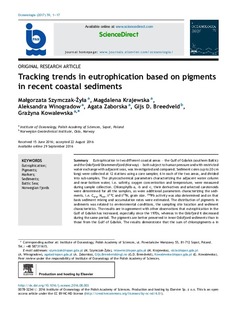| dc.description.abstract | Eutrophication in two different coastal areas – the Gulf of Gdańsk (southern Baltic) and the Oslofjord/Drammensfjord (Norway) – both subject to human pressure and with restricted water exchange with adjacent seas, was investigated and compared. Sediment cores (up to 20 cm long) were collected at 12 stations using a core sampler, 6 in each of the two areas, and divided into sub-samples. The physicochemical parameters characterizing the adjacent water column and near-bottom water, i.e. salinity, oxygen concentration and temperature, were measured during sample collection. Chlorophylls-a, -b and -c, their derivatives and selected carotenoids were determined for all the samples, as were additional parameters characterizing the sediments, i.e. Corg, Ntot, δ13C and δ15N, grain size. 210Pb activity was also determined and on that basis sediment mixing and accumulation rates were estimated. The distribution of pigments in sediments was related to environmental conditions, the sampling site location and sediment characteristics. The results are in agreement with other observations that eutrophication in the Gulf of Gdańsk has increased, especially since the 1970s, whereas in the Oslofjord it decreased during the same period. The pigments are better preserved in inner Oslofjord sediments than in those from the Gulf of Gdańsk. The results demonstrate that the sum of chloropigments-a in sediments calculated per dry weight of sediments is a valuable measure of eutrophication, providing that the monitoring site is selected properly, i.e. sediments are hypoxic/anoxic and non-mixed. Besides, the results confirm previous observations that the percentages of particular chlorophyll-a derivatives in the sum of chloropigments-a are universal markers of environmental conditions in a basin. The ratios of chloropigments-b and chlorophylls-c to the sum of chloropigments-a (ΣChlns-b/ΣChlns-a; Chls-c/ΣChlns-a) may by applied as complementary markers of freshwater and marine organic matter input, respectively. | |
